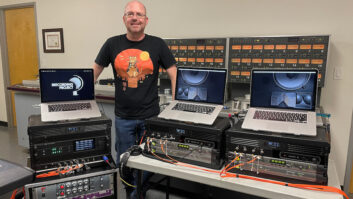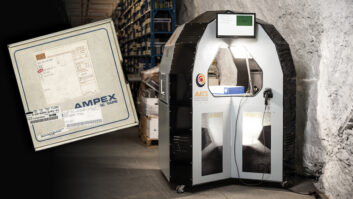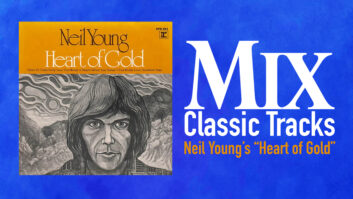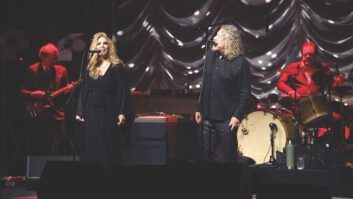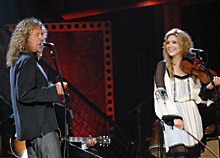
The quintessential Crossroads duo: Robert Plant and Alison Krauss
Photo: Rick Diamond
The Country Music Television (CMT) Series Crossroads, now in its seventh season, brings country artists together in concert with mainstream rock and pop artists, staging one-of-a-kind performances that explore musical roots and where they intersect. The series is curated by CMT, whose producers work to match artists with interesting counterpoints in the Crossroads spirit, a process that has resulted in some remarkable shows, including Kid Rock and Hank Williams Jr., James Taylor and the Dixie Chicks, Martina McBride and Pat Benatar, Brad Paisley and John Mayer, Reba McEntire and Kelly Clarkson and the most recent: the seemingly made-for-Crossroads duo Robert Plant and Alison Krauss.
Crossroads is the brainchild of MTV Networks executive VP Bill Flanagan, also the creator of VH1’s Storytellers. In addition to the collaboration happening onstage, there’s intense teamwork going on behind the scenes to get this show together on a very tight schedule. Nashville-based music producer/engineer Tom Davis and MTV Networks Nashville senior audio engineer Stan “Quack” Dacus serve as Crossroads’ audio co-producers. Dacus tracks the program out of MTV’s Pro Tools HD-equipped R8 mobile recording truck, and Davis and his team at SeisMic Sound Inc. handle the mix to picture and all-around audio post-production.
EPISODE PLANNING, PREPARATIONS
To prepare for an episode, Dacus and Davis work with the artists’ tour managers to devise a manageable stage setup, requiring some paring down of bands and equipment. Because the country artists will perform the songs of the other featured artist and vice versa — for example, Ryan Adams singing lead on Elton John’s “Rocket Man” — or in total duet — as in Joss Stone and LeAnn Rimes performing Rimes’ “Nothin’ Better to Do” — the bands will either switch off to play their respective songs or combine in some fashion as a “house band.”
“There are so many wild cards involved,” says Davis. “Every artist and every band is different, so we have a certain way we go about preparing and setting up, to a point. A lot of times, these are touring artists who are coming in with their full band, their own front-of-house and monitor mixers, and their own preferred microphones and equipment. We’ll start by looking over the input list on what these guys are using; if we can, we’ll stick closely to that.”
With just two days of on-site production setup and rehearsal, Dacus and Davis hear from the artists and management as the actual set lists develop. Dacus explains: “We’ll start out with their full-tilt touring package, but by the time they figure out what songs they’ll be doing, we can weed out a lot of unnecessary instrumentation and background vocals. As rehearsals get underway, the two full-stage setups can often be whittled down to something more manageable.”
By design, Crossroads is meant to be an intimate performance with a small audience seated close together and close to the stage. With the exception of a few shows — Sheryl Crow and Willie Nelson in Los Angeles, Bon Jovi and Sugarland, as well as Brad Paisley and John Mayer in New York City — Crossroads happens on country music turf. It’s typically shot on a Nashville soundstage set up to seat an audience of 200 to 300, with sound reinforcement support by Clair-Showco Nashville. The program has gone much bigger in size — as in the case of Kenny Rogers and Lionel Richie, who shot their episode at the Ryman Auditorium — and in sound, as with one of the earliest episodes. “One of the first shows we did was ZZ Top and Brooks & Dunn, and it was the first and last time we had both bands, including two drummers and two bass players, playing at the same time,” says Davis. “The show ended up sounding really good, but it was quite a process in the remix to sort that all out and ultimately figure out what we could turn off.”
By contrast, Dacus describes the most recent setup: the yet-to-air Crossroads featuring Sara Evans and Maroon 5. “Maroon 5’s Adam Levine sang Sara’s songs in duet with her and her band, and she sang with Maroon 5. We’ll either have the two complete bands flip-flop or combine, as in the Keith Urban and John Fogerty episode, where it was really just the drummers who switched off.”

In SeisMic Studio A are, from left, assistant remix engineer John Zvolensky, Crossroads audio producer Tom Davis and remix engineer Steve Johnson
FROM STAGE TO BROADCAST
In recent years, Dacus has been recording Crossroads to two 64-track Pro Tools HD rigs at 96k/24-bit. Audio hits the Lawo mic pre’s onstage at “split world” and travels via fiber to the HD rigs in the R8 mobile recording truck. Dacus gets a live mix up on the Lawo 56-input mc266 digital production console onboard. “I’ll do the best mix I can on the monitor side of the console,” Dacus notes, “EQ’ing only the monitor path so that we always hold on to the original source.”
The show comes to Davis on a couple FireWire drives and is quickly transferred into SeisMic’s RAID array. As the show will be an hour-long broadcast, Crossroads producers and artists will weigh in on which songs of a longer set will make the cut. Davis and his head engineer, Steve Johnson, will listen to the recordings and line mix, check out the artist and producer’s notes, and put together a first-pass mix, usually unsupervised. “Crossroads needs to have a richness to it,” says Davis. “It needs to sound live, but never be rough. We will polish it a bit, but generally our main goal is to mix it in a way that puts viewers tenth-row center and, of course, always make it sound like it looks.”
For the past few years, as Davis has become more of a supervising audio producer for the show, Johnson has been mixing the show on SeisMic’s Euphonix CS2000 digitally controlled analog console. “I honestly believe that the Euphonix is part of the sound of Crossroads; there’s so much depth and warmth to it,” says Davis. “We’ll mix onto a Fairlight MFX, which I find to be a really great editing system, and then back into Pro Tools HD3, so we’re using some older technology, as well as all the editing capabilities and plug-ins — especially for vocals — in Pro Tools.”
Being trusted old hands by this point, Johnson and Davis will do the bulk of their work during this first-pass stage, mixing in stereo and 5.1 surround for MTV’s MHD channel. “We mix it discretely in 5.1, but when we’re making all of our minute mix decisions, we’re monitoring the down-mix in stereo,” says Davis. “Generally, we want the viewers to experience this as if they’re hearing the best live P.A. they’ve ever heard, and the way you get that is by mixing with depth.”
Johnson and Davis bring depth to their mixes using a combination of compression and subtle reverb, choosing from TC Electronic’s System 6000 and M5000, as well as Eventide’s H3000, an old Ibanez reverb and Digidesign’s ReVibe plug-in. On vocals, they’ll use Universal Audio LA-2A and Pultec plug-ins. “You don’t hear the reverbs as much as you feel them,” notes Davis, “and that feeling always corresponds with what you’re seeing onstage. The drums, for example, need to sit behind the vocals, not to the side. We mix front-to-back and left-to-right.”
Appropriate audience levels and placement within the stereo and surround soundfields will help draw the viewer at home into the Crossroads experience. According to Davis, audience mics will typically be placed off to the side of the venue, out of the camera shots. “We always use condenser mics, and we’ll point them in at the audience from the sides,” says Davis. “We’ll use shotgun mics, like the Sennheiser MKH-416s, which have enough rejection when pointed away from the P.A. To get the intimacy of the room across, you really want to hear individual voices, not huge roars of applause, so I’ve always been a fan of getting the mics in close on the audience. If it sounds too sparse, I can always fix that by laying in or doubling that up with applause from the top or another part of the show.”
Working with such legendary vocalists on Crossroads, the mixers will sometimes incorporate artist-specific effects. “Robert Plant has an 88-millisecond delay on his vocal,” says Davis. “It’s just a short little slap echo, but it’s been part of his sound for so long, so we mixed that in on his recent Crossroads with Alison Krauss,” Davis describes. “And similarly, John Fogerty has always had this 45-millisecond kind of triple-slap as part of his vocal sound, so we applied a slight slap-echo effect on his vocal, as well.”
After spending up to 10 days on first-pass mixes, SeisMic will upload the stereo mix for the video editors, who begin sending out the first cuts to artists, managers and producers. Davis and Johnson will address any requested changes immediately and then wait on the editors to lock the show. “We’ll get an OMF with a QuickTime video and sync up our 5.1 mixes and conform the show,” says Davis. “We’ll clean up any dialog issues, do audience sweetening and masque edits, and we’ll print down to final 5.1 and stereo stems. We send it over to CMT, where it lays back to their HD master and out it goes.”
Janice Brown is a New York-based freelance writer.


